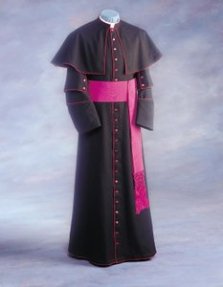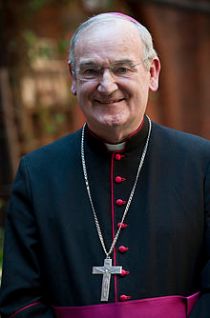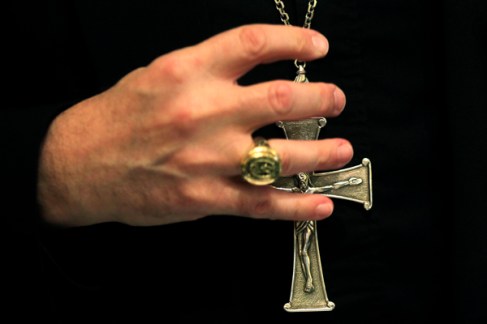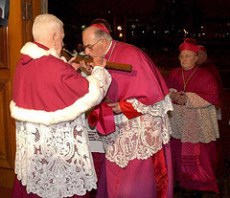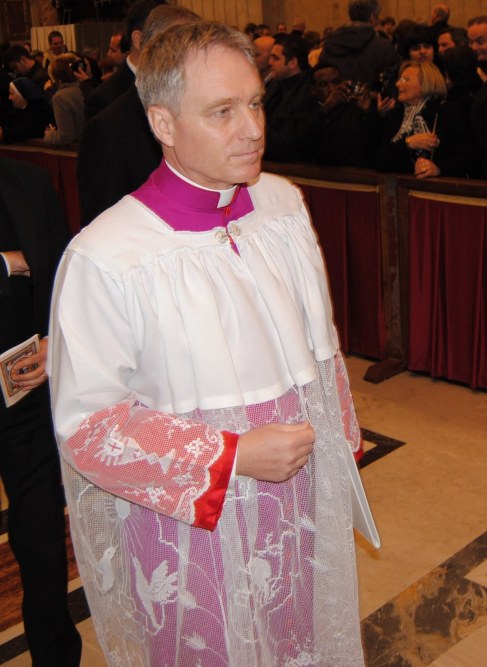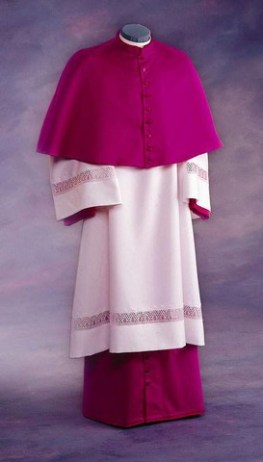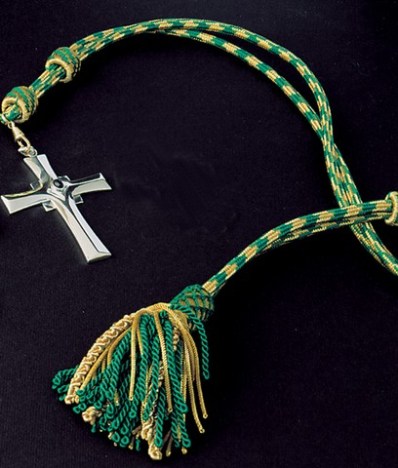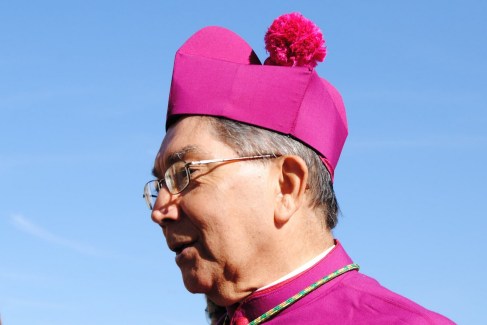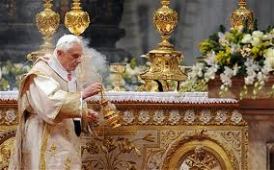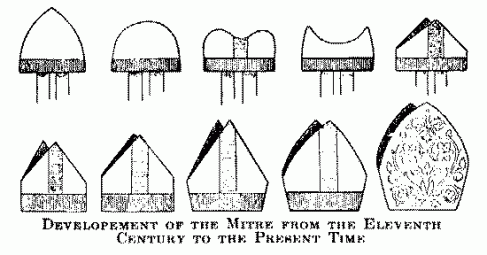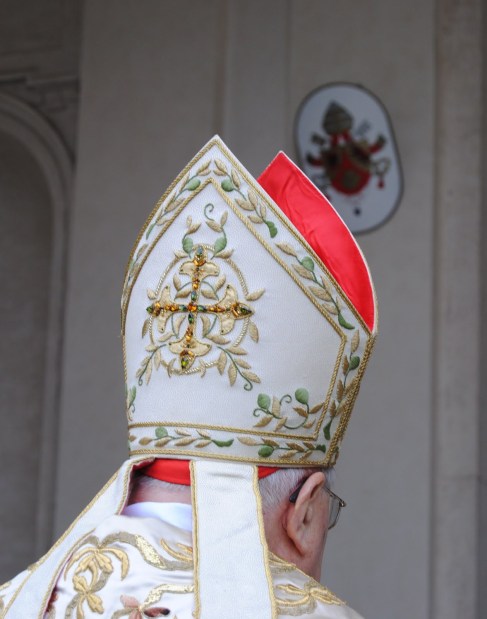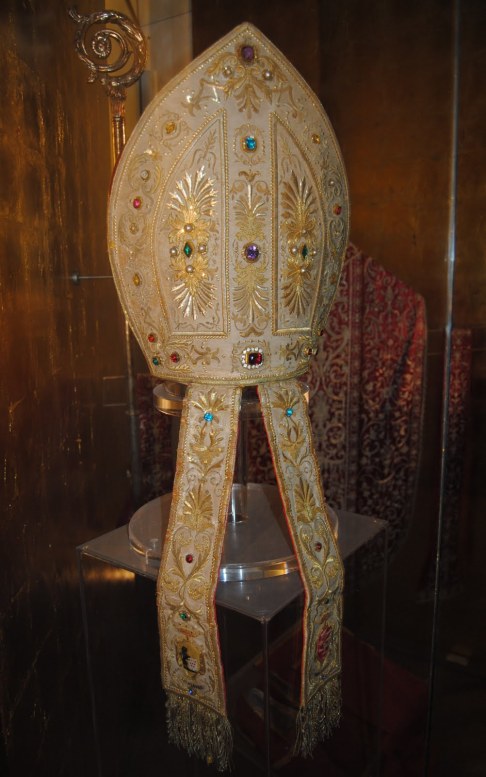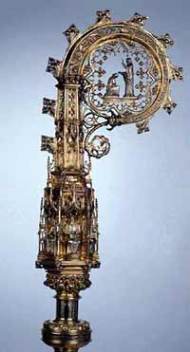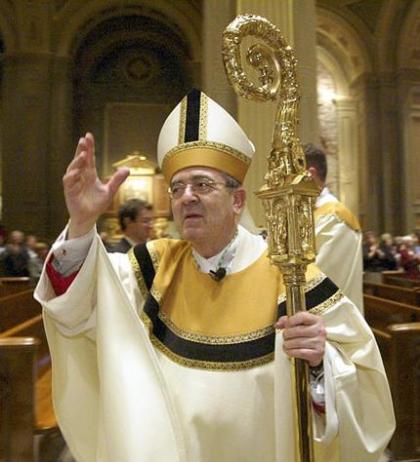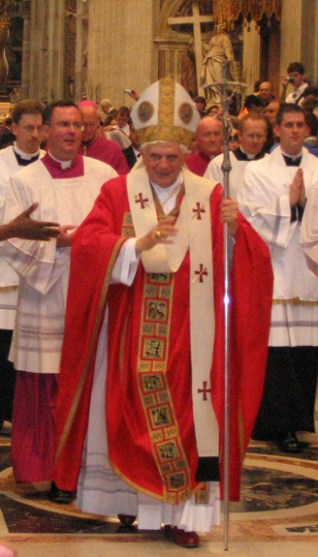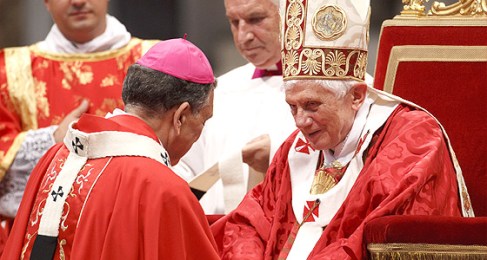What is an Episcopal Ordination? It is the event celebrated with a Mass that mark the continuation of the Apostolic ministry to a new bishop, signified most importantly by the laying of hands by other bishops and the presiding bishop (consecrator), and the imposition of the pontificalia or the vestments and items particular to bishops, which are all representative of his ministry as bishop.
I have written this in conjunction with the Episcopal Ordination of the Coadjutor Archbishop of the Archdiocese of Singapore, Archbishop William Goh Seng Chye, which will be held in the EXPO, Singapore on Friday, 22 February 2013, on the Feast of Chair of St. Peter.
Some terms :
Consecrator : the main presiding bishop at the Episcopal Ordination, similar to celebrant in the celebration of the Mass. In the case of Friday’s ordination, it will be the Apostolic Nuncio to Singapore, Archbishop Leopoldo Girelli
Co-consecrators : the assistant bishops at the Episcopal Ordination, similar to concelebrant in the celebration of the Mass. In the case of Friday’s ordination, it will be the Archbishop of Singapore, Archbishop Nicholas Chia, and the Metropolitan Archbishop of Kuala Lumpur, Archbishop Murphy Pakiam.
Other bishops present in the Ordination can also help out with the laying of the hands, following that of the consecrator and co-consecrator’s laying of hands.
The ceremony itself will begin as a usual Mass would, beginning with the entrance procession. The new bishop to be ordained usually walks in front of the presiding bishop (consecrator), and usually accompanied by two deacons (just as all bishops should, that means the presiding bishop too when available should also have two deacons to accompany him).
Then begin the Mass as usual with the incensing of the altar, the sign of the Cross, the opening address if there is any, and followed by the Penitential Act (I confess to Almighty God…) and the Kyrie (Lord have mercy). Gloria follows after that. One may ask that this is Lenten season where Gloria is not used, but the day of the ordination for this case, 22 February falls on the Feast of Chair of St. Peter where Gloria is used (as is Te Deum later in the ceremony).
After Gloria concludes, then it comes to the opening prayer, and then the readings come as per the usual Mass. First Reading, followed by the Psalm, and finally by the Gospel. No Alleluia for this case since it happens during Lent, and at Lent Alleluia is always omitted, so we have the Lenten Gospel Acclamation instead.
After the Gospel, the Ordination ceremony proper begins.
The first part begins with usually the singing of the Hymn of the Holy Spirit (Veni Creator Spiritus), with all the verses used. Then after the Hymn is completed, this is followed by the presentation of the Bishop/Archbishop-elect, that is Coadjutor Archbishop-elect William Goh in this case (He is not yet legally and validly bishop at this point).
The presiding bishop can give a homily following the presentation of the Bishop-elect, usually to explain on the ministry of the bishop and the nature of that ministry.
Then the promise/vow of the bishop-elect follows, where the new Bishop solemnly vows before God his promise : (In Latin and English)
1. Latin : Antiqua sanctorum Patrum institutio praecipit, ut, qui Episcopus ordinandus est, coram populo interrogetur de proposito fidei servandae et muneris exsequendi.
Vultis ergo, frater carissimus (fratres carissimi if plural), munus nobis ab Apostolis creditum et vobis per impositionem manuum nostrarum tradendum cum gratia Spiritus Sancti usque ad mortem explere?
English : The ancient rule of the holy Fathers ordains that a Bishop-elect is to be questioned in the presence of the people on his resolve to uphold the faith and to discharge his duty.
And so dear brothers, do you resolve by the grace of the Holy Spirit to discharge until death the office entrusted to us by the Apostles, which we are about to pass on to you by the laying on of our hands?
The bishop-elect answers : Volo (English : I do)
2. Latin : Vultis Evangelium Christi fideliter et indesinenter praedicare?
English : Do you resolve to preach the Gospel of Christ with constancy and fidelity?
The bishop-elect answers : Volo (English : I do)
3. Latin : Vultis depositum fidei, secundum traditionem inde ab Apostolis in Ecclesia semper et ubique servatam, purum et integrum custodire?
English : Do you resolve to guard the deposit of faith, entire and incorrupt, as handed down by the Apostles and preserved in the Church everywhere and at all times?
The bishop-elect answers : Volo (English : I do)
4. Latin : Vultis corpus Christi, Ecclesiam eius, aedificare et eius unitate cum Ordine Episcoporum, sub auctoritate successoris beati Petri Apostoli, permanere?
English : Do you resolve to build up the body of Christ, His Church, and to remain in the unity of that body together with the Order of Bishops under the authority of the successor of Saint Peter the Apostle?
The bishop-elect answers : Volo (English : I do)
5. Latin : Vultis beati Petri Apostoli successori, obaedientiam fideliter exhibere?
English : Do you resolve to render obedience faithfully to the succesor of the blessed Apostle Peter?
The bishop-elect answers : Volo (English : I do)
6. Latin : Vultis plebem Dei sanctam, cum comministris vestris presbyteris et diaconis, ut pii pater, fovere et in viam salutis dirigere?
English : Do you resolve to guide the holy people of God in the way of salvation as devoted father and sustain them with the help of your fellow ministers, the priests, and deacons?
The bishop-elect answers : Volo (English : I do)
7. Latin : Vultis pauperibus et peregrinis omnibusque indigentibus propter nomen Domini affabiles et misericordes vos praebere?
English : Do you resolve, for the sake of the Lord’s Name, to be welcoming and merciful to the poor, to strangers, and to all who are in need?
The bishop-elect answers : Volo (English : I do)
8. Latin : Vultis oves errantes ut boni pastores requirere et ovili dominico aggregare?
English : Do you resolve as good shepherds to seek out the sheep who stray and gather them into the Lord’s fold?
The bishop-elect answers : Volo (English : I do)
9. Latin : Vultis Deum omnipotentem pro populo sancto indesinenter orare et sine reprehensione summi sacerdotii munus explere?
English : Do you resolve to pray without ceasing to Almighty God for the holy people and to carry out the office of high priest without reproach?
The bishop-elect answers : Volo, Deo auxiliante (English : I do, with the help of God)
After this, the Litany of the Saints begins, asking the prayer from all the saints, martyrs, and all holy men of God to pray for the new bishop. The bishop-elect prostrate himself on the floor as a sign of humility before God, during the Litany of the Saints.
(R = reply) (Here shown both Latin and English versions)
1. Kyrie, eleison R : Kyrie, eleison
Lord, have mercy R : Lord, have mercy
2. Christe, eleison R : Christe, eleison
Christ have mercy R : Christ, have mercy
3. Kyrie, eleison R : Kyrie, eleison
Lord have mercy R : Lord, have mercy
4. Sancta Maria, Mater Dei R : ora pro nobis
Holy Mary, Mother of God R : pray for us
5. Sancte Michael R : ora pro nobis
Saint Michael R : pray for us
6. Sancti Angeli Dei R : orate pro nobis
Holy Angels of God R : pray for us
7. Sancte Ioannes Baptista R : ora pro nobis
Saint John the Baptist R : pray for us
8. Sancte Ioseph R : ora pro nobis
Saint Joseph R : pray for us
9. Sancte Petre R : ora pro nobis
Saint Peter R : pray for us
10. Sancte Paule R : ora pro nobis
Saint Paul R : pray for us
11. Sancte Andrea R : ora pro nobis
Saint Andrew R : pray for us
12. Sancte Iacobe R : ora pro nobis
Saint James R : pray for us
13. Sancte Ioannes R : ora pro nobis
Saint John R : pray for us
14. Sancte Thoma R : ora pro nobis
Saint Thomas R : pray for us
15. Sancte Iacobe R : ora pro nobis
Saint James R : pray for us
16. Sancte Philippe R : ora pro nobis
Saint Philip R : pray for us
17. Sancte Bartholomae R : ora pro nobis
Saint Bartholomew R : pray for us
18. Sancte Matthae R : ora pro nobis
Saint Matthew R : pray for us
19. Sancte Simon R : ora pro nobis
Saint Simon R : pray for us
20. Sancte Thaddae R : ora pro nobis
Saint Thaddeus R : pray for us
21. Sancte Matthia R : ora pro nobis
Saint Matthew R : pray for us
22. Sancta Maria Magdalena R : ora pro nobis
Saint Mary Magdalene R : pray for us
23. Sancte Stephane R : ora pro nobis
Saint Stephen R : pray for us
24. Sancte Ignati Antiochene R : ora pro nobis
Saint Ignatius of Antioch R : pray for us
25. Sancte Laurenti R : ora pro nobis
Saint Lawrence R : pray for us
26. Sanctae Perpetua et Felicitas R : orate pro nobis
Saint Perpetua and Saint Felicity R : pray for us
27. Sancta Agnes R : ora pro nobis
Saint Agnes R : pray for us
28. Sancte Georgi R : ora pro nobis
Saint George R : pray for us
29. Sancte Fortunate R : ora pro nobis
Saint Fortunatus R : pray for us
30. Sancte Gregori R : ora pro nobis
Saint Gregory R : pray for us
31. Sancte Augustine R : ora pro nobis
Saint Augustine R : pray for us
32. Sancte Athanasi R : ora pro nobis
Saint Athanasius R : pray for us
33. Sancte Basili R : ora pro nobis
Saint Basil R : pray for us
34, Sancte Martine R : ora pro nobis
Saint Martin R : pray for us
35. Sancte Nicolae R : ora pro nobis
Saint Nicholas R : pray for us
36. Sancte Benedicte R : ora pro nobis
Saint Benedict R : pray for us
37. Sancte Francisce et Dominice R : orate pro nobis
Saint Francis and Saint Dominic R : pray for us
38. Sancte Francisce Xavier R : ora pro nobis
Saint Francis Xavier R : pray for us
39. Sancte Vincenti de Paul R : ora pro nobis
Saint Vincent de Paul R : pray for us
40. Sancte Ioannes Maria Vianney R : ora pro nobis
Saint John Mary Vianney R : pray for us
41. Sancta Catharina Senensis R : ora pro nobis
Saint Catherine of Siena R : pray for us
42. Sancta Teresia a Iesu R : ora pro nobis
Saint Teresa of Jesus R : pray for us
43. Omnes Sancti et Sanctae Dei R : orate pro nobis
All holy men and women, Saints of God R : pray for us
44. Propitius esto R : libera nos, Domine
Lord, be merciful R : Lord, deliver us, we pray
45. Ab omni malo R : libera nos, Domine
From all evil R : Lord, deliver us, we pray
46. Ab omni peccato R : libera nos, Domine
From every sin R : Lord, deliver us, we pray
47. A morte perpetua R : libera nos, Domine
From everlasting death R : Lord, deliver us, we pray
48. Per incarnationem tuam R : libera nos, Domine
By Your incarnation R : Lord, deliver us, we pray
49. Per mortem et resurrectionem tuam R : libera nos, Domine
By Your death and resurrection R : Lord, deliver us, we pray
50. Per effusionem Spiritus Sancti R : libera nos, Domine
By the outpouring of the Holy Spirit R : Lord, deliver us, we pray
51. Peccatores R : Te rogamus, audi nos
Be merciful to us sinners R : Lord, we ask You, hear our prayer
52. Ut Ecclesiam tuam sanctam regere et conservare digneris
R : Te rogamus, audi nos
Govern and protect your Holy Church
R : Lord, we ask You, hear our prayer
53. Ut domnum apostolicum et omnes ecclesiasticos ordines in sancta religione conservare digneris
R : Te rogamus, audi nos
Keep the Pope and all the ordained in faithful service to Your Church
R : Lord, we ask You, hear our prayer
54. Ut hos electos benedicere digneris R : Te rogamus, audi nos
Bless these (this) chosen men (man) R : Lord, we ask You, hear our prayer
55. Ut hos electos benedicere et santificare digneris
R : Te rogamus, audi nos
Bless and sanctify these (this) chosen men (man)
R : Lord, we ask You, hear our prayer
56. Ut hos electos benedicere et sanctificare et consecrare digneris
R : Te rogamus, audi nos
Bless, sanctify, and consecrate these (this) chosen men (man)
R : Lord, we ask You, hear our prayer
57. Ut cunctis populis pacem et veram concordiam donare digneris
R : Te rogamus, audi nos
Bring all peoples together in peace and true harmony
R : Lord, we ask You, hear our prayer
58. Ut omnis in tribulatione versantibus misericordiam tuam largiri digneris
R : Te rogamus, audi nos
Comfort with Your mercy the troubled and the afflicted
R : Lord, we ask You, hear our prayer
59. Ut nosmetipsos in tuo sancto servitio confortare et conservare digneris
R : Te rogamus, audi nos
Strengthen all of us and keep us in Your holy service
R : Lord, we ask You, hear our prayer
60. Iesu, Fili Dei vivi R : Te rogamus, audi nos
Jesus, Son of the living God R : Lord, we ask You, hear our prayer
61. Christe, audi nos R : Christe, audi nos
Christ, hear us R : Christ, hear us
62. Christe, exaudi nos R : Christe, exaudi nos
Christ, graciously hear us R : Christ, graciously hear us
(The Litany of the Saints is slightly different and longer than the usual one as this one is used for the Episcopal Ordination Mass proper, which contains more prayers for the bishop-elect)
Then the presider will pray this prayer after the Litany :
Latin : Propitiare, Domine, supplicationibus nostris, et inclinato super hos famulos tuos cornu gratiae sacerdotalis, benedictionis tuae in eos effunde virtutem. Per Christum Dominum nostrum. Amen.
English : Graciously hear our petitions, o Lord, and pour out upon these, Your servants, the power of Your blessing, flowing from the horn of priestly grace. Through Christ our Lord. Amen.
The imposition or laying of hands then follow. Beginning with the consecrator and the co-consecrators, they lay their hands on the bishop-elect’s head, as a sign of the passing down of the Holy Spirit they themselves have received through the Apostolic Succession, from the Apostles, and therefore from Christ.
(During this time, the other bishops in attendance may also lay their hands on the head of the new Bishop as a symbol of the continuing power that came from the Apostles, the unbroken Apostolic Succession from the Apostles themselves, empowering the new Bishop with the same authority and power God has given to the Apostles).
Then this is followed by the placing of the Holy Scripture opened up above the head of the new Bishop, as a symbol that the new Bishop will stay true to the Word of God in the Scripture, and will do his best to carry out the will of God, and make the Word of God centre of his life and his mission as the Bishop, as the shepherd of God’s people.
The moment and words that made an Episcopal Ordination valid and legal (when done by the proper authority and in accordance with the Canon Law) are highlighted in bold below. The Principal consecrator then pray together with the co-consecrators and the other bishops over the new Bishop (with the Sacred Scripture above his head).
Latin : Deus et Pater Domini nostri Iesu Christi, Pater misericordiarum et Deus totius consolationis, qui in excelsis habeas et humilia respicis, qui cognoscis omnia antequam nascantur, tu qui dedisti in Ecclesia tua normas per verbum gratiae tuae, qui praedestinasti ex principio genus iustorum ab Abraham, qui constituisti principes et sacerdotes, et sanctuarium tuum sine ministerio non dereliquisti, cui ab initio mundi placuit in his quos eligisti glorificari :
Et nunc effunde super hos electos eam virtutem, quae a te est, Spiritum principalem, quem dedisti dilecto Filio tuo Iesu Christo, quem ipse donavit sanctis Apostolis, qui constituerunt Ecclesiam per singula loca ut sanctuarium tuum, in gloriam et laudem indeficientem nominis tui.
Da, cordium cognitor Pater, his servis tuis, quos elegisti ad Episcopatum, ut pascant gregem sanctum tuum, et suum sacerdotium tibi exhibeant sine reprehensione, servientes tibi nocte et die, ut incessanter vultum tuum propitium reddant et offerant dona sanctae Ecclesiae tuae; da ut virtute Spiritus summi sacerdotii habeant potestatem dimittendi peccata secundum mandatum tuum; ut distribuant munera secundum praeceptum tuum et solvant omne vinculum secundum potestatem quam dedisti Apostolis; placeant tibi in mansuetudine et mundo corde, offerentes tibi odorem suavitatis, per Filium tuum Iesum Christum, per quem tibi gloria et potentia et honor, cum Spiritu Sancto in sancta Ecclesia et nunc et in saecula saeculorum. Amen.
English : God and Father of our Lord Jesus Christ, Father of mercies and God of all consolation, who dwell on high and look on the lowly, who know all things before they come to be; and who laid down observances in Your Church through the word of Your grace; who from the beginning, foreordained a nation of the just, born of Abraham; who established rulers and priests and did not leave Your sanctuary without ministers, and who, from the foundation of the world, were pleased to be glorified in those You have chosen :
Pour out now upon these (this) chosen ones (one) that power which is from You, the Spirit of governance whom You gave to Your beloved Son, Jesus Christ, the Spirit whom He bestowed upon the holy Apostles, who established the Church in each place as Your sanctuary for the glory and unceasing praise of Your Name.
Grant, o Father, knower of all hearts, that these (this), Your servant(s), whom You have chosen for the office of Bishop may shepherd Your holy flock, Serving You night and day, may they fulfill before You without reproach the ministry of the High Priesthood; so that, always gaining Your favour, they (he) may offer up the gifts of Your Holy Church. Grant that, by the power of the Spirit of the High Priesthood, they may have the power to forgive sins according to Your command, assign offices according to Your decree, and loose every bond according to the power given by You to the Apostles. May they please You by their meekness and purity of heart, presenting a fragrant offering in You, through Your Son, Jesus Christ, through whom glory and power and honor are Yours with the Holy Spirit in the Holy Church, now and forever. Amen.
After this, the consecrator bishop will anoint the hands of the new Bishop with the sacred chrism oil, signifying that the bishop is the anointed one of God, given by God the authority of the High Priesthood of Christ, which he share.
Latin : Deus, qui summi Christi sacerdotii participem te effecit, ipse te mysticae delibutionis liquore perfundat, et spiritualis benedictionis ubertate fecundet.
English : May God, who has made you a sharer in the High Priesthood of Christ, Himself pour out upon you the oil of mystical anointing and make you fruitful with an abundance of spiritual blessings.
Then, the new Bishop receives the Book of the Gospels (Evangelium), the Word of God, to remind him of his duty to teach and preach the word of God to his flock.
Latin : Accipe Evangelium et verbum Dei praedica in omni patientia et doctrina.
English : Receive the Gospel and preach the word of God with all patience and sound teaching.
Then, the new Bishop receives the Episcopal ring, the sign that he is married to God and His Holy Church, and thus the flock he is entrusted to.
Latin : Accipe anulum, fidei signaculum : et sponsam Dei, sanctam Ecclesiam, intemerata fide orantus, illibate custodi.
English : Receive this ring, the seal of fidelity : adorned with undefiled faith, preserve unblemished the bride of God, the holy Church.
Then, the new Bishop receives the mitre, the symbol of authority, that he now teach as the teacher of faith in the authority given to Him by Christ, and as a crown of glory and holiness given to him by Christ.
Latin : Accipe mitram, et clarescat in te splendor sanctitatis, ut cum apparuerit princeps pastorum, immarcescibilem gloriae coronam percipere merearis.
English : Receive the mitre, and may the splendour of holiness shine forth in you, so that when the Chief Shepherd appears you may deserve to receive from Him an unfading crown of glory.
Finally, the new Bishop receives the pastoral crosier, which is a symbol of his pastoral office as a shepherd to God’s people, the sheep entrusted to him to care, and to govern through the authority given to him by the Holy Spirit.
Latin : Accipe baculum, pastoralis muneris signum, et attende universo gregi, in quo te Spiritus Sanctus posuit Episcopum regere Ecclesiam Dei.
English : Receive the crosier, the sign of your pastoral office, and keep watch over the whole flock in which the Holy Spirit has placed you as Bishop to govern the Church of God.
After all are done, the new Bishop is presented to the people and all the faithful. An appropriate hymn, or hymn in honour of the new Bishop may be sung or played at this time. Then the Mass proceeds as normal with the Creed.
The Mass and the Eucharist, and then the Communion proceed as it is in a normal Mass. Then, after the concluding prayer (Prayer after Communion) is said, Te Deum is usually sung. Te Deum as the hymn that glorifies God and usually sang at events including ordinations, and show that through the ordination of this new bishop, God’s glory is made manifest in this world.
Te Deum
Te Deum laudamus, te Dominum confitemur
We praise You, o God, we acclaim You as the Lord.
Te aeternum Patrem, omnis terra veneratur.
Everlasting Father, all the world bows down before You.
Tibi omnes angeli, tibi caeli et universae potestatis;
All the angels sing Your praise, the hosts of heaven and all the angelic powers;
tibi cherubim et seraphim incessabili voce proclamant :
all the cherubim and seraphim call out to You in unending song :
Sanctus, Sanctus, Sanctus Dominus Deus Sabaoth.
Holy, Holy, Holy, is the Lord of God of the angelic hosts.
Pleni sunt caeli et terra, maiestatis gloriae tuae.
The heavens and the earth are filled with Your majesty and glory.
Te gloriosus Apostolorum chorus,
The glorious band of apostles,
te prophetarum laudabilis numerus,
the noble company of prophets,
te martyrum candidatus laudat exercitus.
the marytrs who shed their blood for Christ, all sing Your praise.
Te per orbem terrarum sancta confitetur Ecclesia,
And to the ends of the earth, Your Holy Church proclaims her faith in You,
Patrem immensae maiestatis;
Father, whose majesty is boundless;
venerandum tuum verum et unicum Filium;
Your true and only Son, who is to be adored;
Sanctum quoque Paraclitum Spiritum.
the Holy Spirit sent to be our Advocate.
Tu rex gloriae, Christe.
You, Christ, are the King of glory.
Tu Patris sempiternus es Filius.
Son of the Eternal Father.
Tu, ad liberandum suscepturus hominem, non horruisti Virginis uterum.
When You took our nature to save mankind, You did not shrink from birth in the Virgin’s womb.
Tu, devicto mortis aculeo, aperuisti credentibus regna caelorum.
You overcame the power of death, opening the Father’s kingdom to all who believe in You.
Tu ad dexteram Dei sedes, in gloria Patris.
Enthroned at God’s right hand, in the glory of the Father.
Iudex crederis esse venturus.
You will come in judgement according to Your promise.
Te ergo quaesumus, tuis famulis subveni, quos pretioso sanguine redemisti.
You redeemed Your people by Your Precious Blood. Come, we implore You, to our aid.
Aeterna fac cum sanctis tuis in gloria numerari.
Grant us with the saints, a place in eternal glory.
Then the Mass ends with the final blessing and dismissal. Thus ends the Episcopal Ordination Mass. The guide above is not conclusive, as there may be variations in the wording and the hymn depending on the local needs and customs.
Let us pray for the Coadjutor Archbishop of Singapore, Msgr. William Goh, that God will truly pour down on him, the Holy Spirit, that he will be a great shepherd to His people, in His Church in Singapore. Amen.
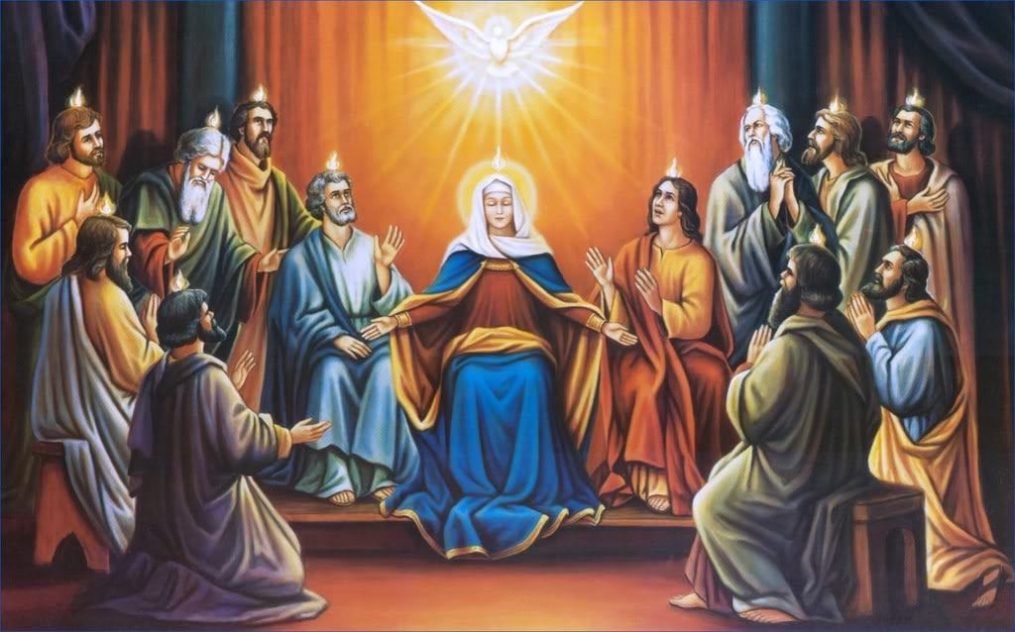
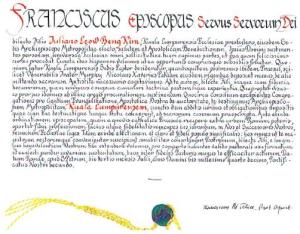


![Cardinal Jose da Cruz Policarpo - Lisboa[1]](https://petercanisiusmichaeldavidkang.com/wp-content/uploads/2014/03/cardinal-jose-da-cruz-policarpo-lisboa1.jpg?w=222&h=300)
